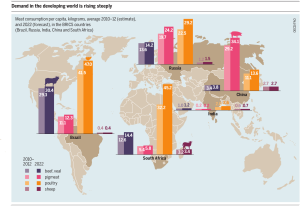2 Emerging Economies
NOR AZMA BINTI RAHLIN
Emerging Economies
An emerging market economy is the economy of a developing nation that is becoming more engaged with global markets as it grows. Countries classified as emerging market economies are those with some, but not all, of the characteristics of a developed market.
Characteristics of developed markets may include strong economic growth, high per capita income, liquid equity and debt markets, accessibility by foreign investors, and a dependable regulatory system.
As an emerging market economy develops, it typically becomes more integrated with the global economy. That means it can have increased liquidity in local debt and equity markets, increased trade volume and foreign direct investment. It can develop modern financial and regulatory institutions. Currently, some notable emerging market economies include India, Mexico, Russia, Pakistan, Saudi Arabia, China, and Brazil.
Critically, an emerging market economy is transitioning from a low income, less developed, often pre-industrial economy towards a modern, industrial economy with a higher standard of living.

” Meat demand in emerging national economies is on the rise” by Heinrich Boell Foundation, Friends of the Earth Europe is licensed under CC BY-SA 3.0
Worldwide meat production increased nearly 5 times in the second half of the 20th century, and the amount eaten per person doubled. By 2050 meat consumption could increase by as much as another 160 percent.
Emerging Economies In Asia

“Southeast Asia’s Fastest Emerging Economies” by ASEAN Analytics is licensed under CC BY-SA 4.0
Many East and South East Asian economies have progressed from low income to middle income status in the last 50 years, prompting the World Bank to coin the term “East Asian Miracle” to describe their achievements in overcoming the development challenges developing countries typically face.1 Rapid transformations have continued since 2000, reflecting the rise of China as well as the emergence of large Association of Southeast Asian Nations (ASEAN) economies including Indonesia, Malaysia, the Philippines, Thailand and Viet Nam.
Country-specific development strategies as well as variations in the pace and sequencing of policies across the different countries have characterized the developments achieved by the individual countries. Nonetheless, broadly speaking, a large part of the success of East and South East Asian economies can be attributed to the “outward-oriented industrialization” model. There are two dimensions to this strategy, namely the productive structures of the economy and their integration in global trade.
Source adopted from “East Asian Miracle’ through industrial production and trade lenses” by Adnan Seric and Yee Siong Tong is licensed under CC BY-SA 4.0

